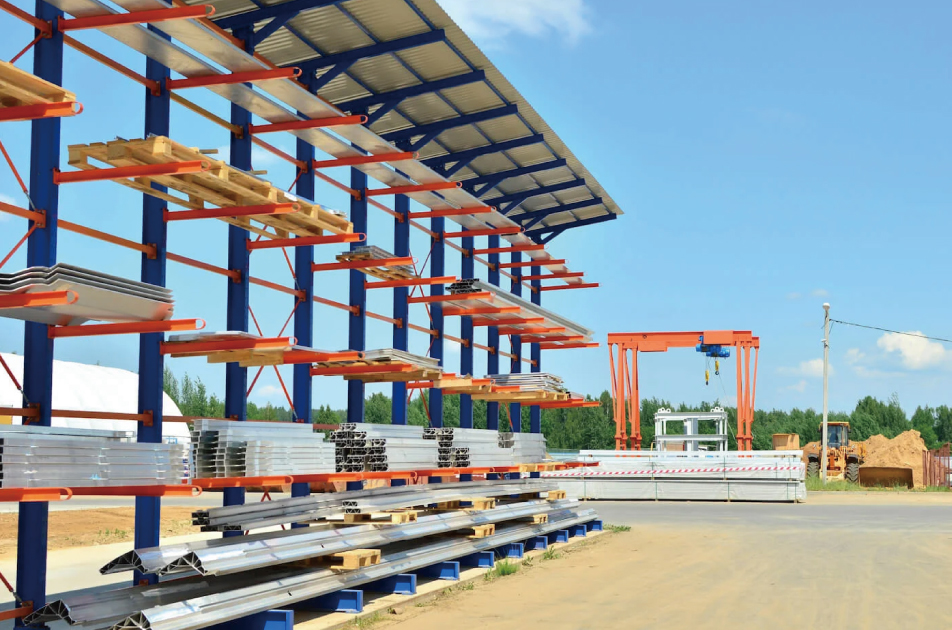All You Have to Know About Cantilever Racks

Introduction
Cantilever racking systems are an essential type of rack for storing long, bulky, or oddly shaped items such as piping, lumber, and structural steel. Unlike traditional pallet racks, roll-formed cantilever racks do not have vertical supports on the front, allowing for easier access.
Understanding how to calculate the capacity of a cantilever pallet racking is vital to ensure safety and efficiency in warehouse operations. This comprehensive guide will walk you through the process of calculating cantilever rack capacity, address common issues and solutions, and provide valuable insights into the pros and cons of cantilever racking systems.
Understanding Cantilever Racking
Cantilever racks are designed to store items that are too long or oddly shaped to fit on traditional pallet racks. The system consists of three main components:
- Uprights: Vertical columns that support the structure.
- Arms: Extend horizontally to hold the load.
- Brace Sets: Connect the uprights, adding stability to the system.
Cantilever racks are favored for their ability to store certain items which are hard to store on standard pallet racks. By eliminating the vertical supports on the front, cantilever racks allow for easy loading and unloading of items, making them ideal for storing materials of various lengths and shapes.
Calculating Cantilever Rack Capacity
Calculating Arm Capacity
To ensure the stability and safety of your cantilever warehouse rack, it is crucial to calculate the capacity of the arms and uprights correctly.
Formula:
Weight capacity per arm = Total product weight per level / Required number of arms
For example, if you have a product weighing 1,000 lbs and you require four arms to support it, each arm should have a capacity of at least 250 lbs. It is important to ensure that the load is evenly distributed and centered on the arms to prevent tip loading.
Steps to Calculate Arm Length and Capacity
- Determine the Product Dimensions: The arms should be slightly longer than the product width to ensure proper support.
- Calculate the Total Product Weight per Level: Sum the weight of all items stored on a single level of the cantilever rack.
- Determine the Number of Arms Required: Perform a test by placing your product on wooden blocks spaced 2 feet apart. If deflection occurs, add more arms.
- Calculate the Weight Capacity per Arm: Divide the total product weight per level by the required number of arms.
Calculating Upright Capacity
Formula:
Capacity required per upright = (Number of arms × Capacity per arm) / Number of uprights
For instance, if your system uses 12 arms and each arm has a capacity of 2,500 lbs, the total capacity equals 30,000 lbs. If your system is using three uprights, then a minimum required capacity of 10,000 lbs per upright is needed.
Practical Example
Let's consider a practical example to illustrate the calculation process.
- Product: Lumber, 10 feet long, 500 lbs each.
- Storage Plan: Four pieces per level, total weight of 2,000 lbs per level.
- Required Arm Length: At least 10 feet.
- Required Number of Arms: Determined through a deflection test.
- Weight Capacity per Arm: 500 lbs per arm (if four arms are used).
- Upright Capacity: (4 arms × 500 lbs) / 3 uprights = 666.67 lbs per upright.
Pros and Cons of Cantilever Racking
Advantages
- Flexibility: Cantilever shelving is highly adjustable for various product sizes.
- Accessibility: No front columns for easier loading and unloading.
- Space Utilization: Maximizes vertical space for long, bulky items.
Disadvantages
- Cost: More expensive than traditional pallet racks.
- Installation Complexity: Requires precise calculation and professional expertise.
- Maintenance: Regular inspections and replacements needed to ensure safety.
Common Issues and Solutions
- Deflection: Ensure the correct number of arms is used and properly spaced.
- Product Rolling: Use inclined arms or arm lips to prevent cylindrical items from rolling off.
- Incorrect Loading: Distribute the load evenly and avoid tip loading.
Steps for Safe Installation
- Inspect All Components: Check arms, uprights, braces, and other components.
- Lay Out the Rack Footprint: Mark the layout on the floor using chalk lines.
- Connect the Cantilever Rack Base: Attach the base to the upright column securely.
- Anchor the Rack to the Floor: Install wedge anchors into the concrete.
- Connect the Arms: Securely fasten the arms to the uprights.
- Install Arm Accessories: Attach arm lips or pipe stops if needed.
- Construct Additional Columns: Follow the same steps for each column.
- Install Bracing: Connect bracing for stability.
- Build Additional Adder Bays: Expand the system as needed.
By following these steps, you can ensure a safe and stable installation of your cantilever racking system, reducing the risk of accidents and damage to stored items.
If cost is a concern, evaluate the state of used cantilever racks for sale and brand-new heavy-duty cantilever steel racking systems before installation.
Do you need more information?
Our team of experts will be happy to help you with any questions you may have.
More information